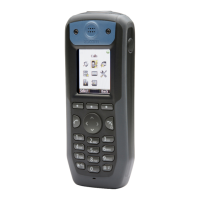TD 92644EN
User Manual
Ascom d81 DECT Handset
7 Menu Operation
54
18 June 2018 / Ver. K
NOTE: Some legacy systems/PBXs require that the handset sends a predefined DTMF tone
when pressing/releasing . See the handset’s Configuration Manual for more
information.
To participate in the conference, the group members must first accept an invitation received
as an incoming call or as a text message. See 7.1.5 Accept an Invitation on page 54.
If a member declines an invitation, he or she can re-join the group or conference later on.
See 7.1.8 Re-join a Group on page 57.
A user can also invite a group of members to participate in a conference call by calling a
PTT group, see 7.1.7 Call a PTT Group on page 56.
7.1.5 Accept an Invitation
Accept Invitation Received as Incoming Call (PTT Basic)
A PTT invitation received as an incoming call is indicated by the icon. In the dialog
window, a message containing maximum 24 characters can also be shown.
Figure 5. Incoming Invitation Received as a Call.
1 Press “Accept”, or .
Default the handset starts in inverted mute and loudspeaking mode, but it can be
configured differently in a PTT group.
2 Press and hold to open the microphone for transmitting. The microphone is
muted again when is released.
NOTE: Some legacy systems/PBXs require that the handset sends a predefined
DTMF when pressing/releasing .
If DTMF is activated, it is not possible to mute the microphone by releasing
during a call. Instead, select More > Microphone off during the call.
Invitation Received as Incoming Call during an Ongoing Call
If a user receives an invitation during an ongoing call, it is displayed as an ordinary
invitation, see Figure 5 on page 54. The user can either accept or decline the invitation by
pressing "Accept" or "Decline", respectively.
NOTE: It is not possible to accept or decline the invitation by pressing or ,
respectively.
If the user presses “Accept”, the ongoing call is disconnected and the PTT call is connected.
12:34
Accept
Decline
009
PTT Group 1
X-ray

